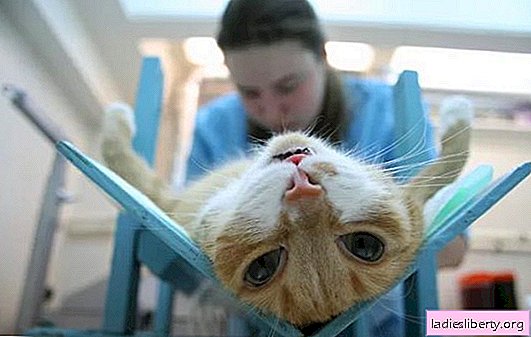
Lymph nodes are the basic components in the human lymphatic system, the main task of which is to develop immune cells.
These cells suppress viruses and other negative factors that penetrate the body from the environment.
Let us consider in more detail the causes of inflammation of the lymph nodes in the neck in a child and methods for eliminating this ailment.
Causes of inflammation of the lymph nodes in the neck in a child
Inflammation of the lymph nodes in the neck in a child or lymphadenitis develops for the following reasons:
1. Infectious diseases are the most common cause of lymphadenitis in children. Moreover, acute viral or respiratory diseases (flu, sore throat, rubella, stomatitis, mumps, chickenpox and others) most often become such diseases.
2. Mechanical damage to the pharynx.
3. Burn of the pharynx.
4. The development of a tumor in the lymphatic tissue.
5. Subcooling.
6. Acute vitamin deficiency.
7. Long-term nervous strain and stress in a child.
8. Anemia.
9. A cut or other damage to the soft tissue on the neck through which microbes can enter and cause inflammation.
10. General decrease in immunity and weakening of the body after a long-running illness.
11. The deterioration of metabolism.
12. Diseases of the upper respiratory tract.
13. Inflammation of the adenoids.
14. Caries.
15. Tonsillitis or sinusitis.
16. An increase in the lymph nodes in the neck as a result of the manifestations of an allergic reaction that has developed into household chemicals, food or smells.
17. The increase in lymph nodes as a reaction of the child's body to a recent vaccination.
Symptoms of inflammation of the lymph nodes in the neck in a child
Usually, inflammation of the lymph nodes in the neck of a child has the following symptoms:
1. First, as soon as the disease is still developing, the baby’s body gradually loses strength. The child becomes lethargic and lethargic. Loses appetite.
2. With the development of inflammation, the baby rises in temperature. Headaches may also appear.
3. The development of a febrile state and sleep disturbance.
4. Pain when swallowing and palpating the area of the lymph nodes on the neck.
5. Redness of the skin over the inflamed nodes and the appearance of swelling of the neck area.
6. General deterioration in the well-being of the child.
7. Sealing of the area of inflamed nodes.
8. Malaise (rash on the body is possible).
9. The appearance of purulent discharge from the larynx is possible with angina and purulent lymphadenitis.
Inflammation of the lymph nodes in the neck in a child: diagnosis and treatment
In order to identify the cause of inflammation of the lymph nodes and begin the correct treatment, a professional medical diagnosis should be carried out. To do this, you need to pass such tests and undergo examinations:
1. General analysis of blood and urine.
2. Examination by a therapist.
3. The study of a piece of lymph node (the procedure is painless and is done under local anesthesia).
4. The study of the inflamed lymph node by introducing a special needle into it, through which its contents are sucked off. This procedure makes it possible to identify the root cause of inflammation of the lymph node.
Inflammation of the lymph nodes in the neck in children has the following treatment features:
1. A small patient must be in bed.
2. The child needs to be given a lot of warm liquid and combined vitamin preparations to strengthen immunity (only as directed by the attending physician).
3. You should adjust the diet and fill the menu with fresh fruits, vegetables and juices from them in order to enrich the body with useful substances.
4. If the disease was caused by viruses or pathologies of the upper respiratory tract, then antibiotics are prescribed for the child. They will relieve acute inflammation and suppress the activity of the infection. The duration of such therapy should be determined by the attending physician. Treatment usually lasts from five to ten days.
5. To maintain the microflora, which may be disturbed when taking antibiotics, bifidobacteria and drugs to improve digestion are prescribed (Linex, Hilak Forte).
6. With no temperature course of the disease, the baby may be prescribed physiotherapeutic treatment (laser radiation, phonophoresis, UHF therapy).
7. If the child’s lymphadenitis is severely started and pus begins to collect in the area of the nodes, then the baby may be prescribed surgical treatment or the installation of special tubes (drains) through which pus will be excreted.
It is important to know, that inflammation of the lymph nodes is a rather specific condition, which, in the absence of timely treatment or incorrect diagnosis, can cause serious complications. For this reason, parents need to know that during therapy it is impossible:
1. Do not give your child medications without a doctor’s prescription.
2. Do not apply iodine mesh to the area of inflamed lymph nodes.
3. Do not warm your throat and apply hot or cold compresses to your neck, as this will further increase inflammation.
4. Do not rub the area of inflammation with alcohol or other warming fluids.
5. Do not give your child hot teas (the liquid should be slightly warm).
The most correct solution for suspected inflammation of the lymph nodes in the baby will be to contact a therapist as soon as possible. After the initial examination, the doctor will decide what to do and assign a list of necessary tests.
At the appointment with a therapist, you need to be prepared for such questions:
1. When was the last vaccination for the child and what exactly?
2. What is the nature of lymph node pain?
3. Are the pains in the baby's throat worse?
4. Have there been any recent bacterial or viral diseases?
5. How often is a child more flu and colds?
Having learned the answers to the above questions, it will be easier for the doctor to compile a clinical picture of the baby’s health status.
Most often, the problem of lymphadenitis on the neck affects children with an age of 5-8 years. This is due to the fact that in such a period of life, babies have not yet fully formed the immunity and protective system of the body, therefore it is more susceptible to various diseases than an adult.
Inflammation of the lymph nodes in the neck in a child: treatment, prevention, prognosis
In the absence of acute symptoms, alternative treatment for inflammation of the lymph nodes in the neck in children can be practiced. Of course, such funds will not be able to completely cure the baby, but they are able to relieve some of the inflammation and pain. The best recipes of this orientation are:
1. A remedy for echinacea is considered one of the most effective folk antiseptics that help get rid of germs with an increase in lymph nodes. To prepare it, you need to mix ten drops of echinacea tincture with 50 ml of warm water. Take this medicine three times a day.
2. Gargle with a decoction of chamomile, calendula and peppermint three times a day.
3. Daily eat a spoonful of honey, while washing it down with warm milk. Honey will not only relieve inflammation, but also strengthen immunity.
4. Means from soda. To prepare it, you need to dissolve a teaspoon of soda and the same amount of salt in a glass of boiling water. Cool slightly and gargle throat three times a day. It will help relieve pain, eliminate germs and reduce inflammation.
5. Aloe remedy. To prepare it, you need to cut aloe leaves and squeeze the juice from them. Ready liquid should be taken on a teaspoon twice a day. Before giving the child this juice, it is recommended to make sure that the baby is not allergic to this plant.
6. Apply jade stone to the inflamed lymph node. It is distinguished by its healing properties and will help relieve swelling and inflammation.
7. Do a light massage with essential oils. To do this, you can use lavender oil, peach or ordinary olive oil. In this case, the movements should be smooth and directed along the neck from top to bottom.
It is important to know, that before using any popular methods for the treatment of inflamed lymph nodes in children, you should consult your doctor to harm the baby.
In order to prevent the appearance of lymphadenitis in a child, one should adhere to such prevention rules:
1. To temper the child.
2. Support the baby’s immune system. To do this, he must eat well, avoid stress and exercise.
3. Make sure that the child regularly walks in the fresh air.
4. Eliminate the possibility of drafts or hypothermia.
5. Timely treat infectious or viral diseases.
6. Each season to give the child vitamin complexes.
7. Visit the dentist on time.
8. Treat with antiseptic solutions even small abrasions and scratches in the neck area, through which microbes can penetrate and cause inflammation.
9. Follow oral hygiene.
The prognosis for lymphadenitis in children in most cases is favorable, especially if the disease was detected on time and treatment started. Otherwise, inflammation of the lymph nodes can lead to dangerous complications that are associated with the attachment of a bacterial infection, exacerbation of existing diseases and the development of phlegmon.
The more serious consequences of inflamed lymph nodes include the development of severe intoxication of the body, abscess and sepsis. At the same time, the purulent process in the area of the lymph nodes will need urgent surgical intervention, the establishment of drains and long-term antibiotic therapy.
Moreover, if you start inflammation of the lymph nodes or do not treat it at all, then pus will begin to collect on the child’s neck and eventually it will burst and penetrate into the tissues. This threatens blood poisoning, a general deterioration of the body and the appearance of large intoxication.











